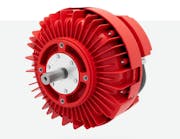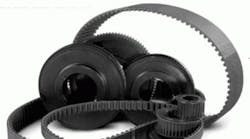Since their invention nearly 100 years ago, V-belts have been the drive of choice for commercial and industrial air-handling applications, providing narrower widths, lower tension, higher horsepower capacity, better alignment capability, longer life, higher efficiency, and lower cost than the flat belts they replaced.
In recent years, synchronous belts have been improved significantly. Today's models offer narrower widths, lower static tension and belt pull, lower operating temperatures, lower maintenance expense, and less noise than previous generations of synchronous belts and higher efficiency than V-belts. With these improvements, synchronous belt drives are being used increasingly in air-handling applications.
Energy Efficiency
As with most other systems, the primary form of energy loss in belt drives is heat generated by friction. There are three primary sources of frictional losses with belt drives:
- Internal friction caused by belt flexion.
- Friction caused by belt tension and contact between the belt and pulley.
- Slippage.
During operation, belts are put through a constant cycle of flexing and relaxing as they pass around pulleys and through straight sections. When this occurs, internal friction produces heat. Because of their design and geometry, standard V-belts have the greatest resistance to bending and, thus, produce the greatest amount of heat. The advent of cogged V-belts represented an improvement in losses attributed to bending stress. Simply switching from a standard V-belt to a cogged V-belt can increase efficiency by about 2 percent.
Synchronous belts are cogged by nature and feature a much flatter design, which greatly reduces internal bending stresses. Some of the first generations of high-capacity synchronous belts utilized stiff aramid fibers as tensile members. Recent designs utilize more flexible advanced fiberglass or "carbon" tensile members to reduce bending stress and improve efficiency.
With V-belt drives, power is transmitted by the friction created by the wedging action of the belts in the sheave grooves. Synchronous drives feature a positive-traction design; they have teeth to transmit the required torque. Friction is reduced significantly by lower belt tension and smaller contact area. Newer synchronous drives utilize low-friction facing materials where the belt contacts the sprocket teeth, improving wear resistance and belt life and further reducing friction.
The friction required to transmit torque with V-belts is obtained through proper tensioning of the belt. Standard V-belts, however, can stretch up to 3 percent of the original length throughout the life of the belt. If proper tension is not maintained, belt tension drops, and the belt can slip. When slip occurs, additional heat is generated between the belts and grooves. Slippage also can occur during torque spikes, such as at startup. Properly selected and installed synchronous belt drives will not slip and do not stretch appreciably.
At the time of installation, V-belt drives can run at 95- to 98-percent efficiency. The efficiency then falls to an average of approximately 93 percent during normal operation. Without regular maintenance, V-drive efficiency can drop as low as 80 percent. Synchronous belt drives consistently operate at an average of 98-percent efficiency, making them, on average, at least 5 percent more efficient than V-belts.
Belt Width
Synchronous belts first were made from steel wire and then fiber glass. To obtain the required horsepower capability, synchronous belts had to be quite wide compared with V-belts. In an industry such as air handling, where space is at a premium, size matters. Not only was physical size a problem, but the greater width meant higher tension, increased bearing load, and installation issues.
Today, synchronous belts are narrower and can replace chain and, in some cases, gears because of their high tensile strength. While most air-handling applications do not require such high horsepower capability, the added capacity allows belt manufacturers to make thinner belts. Thinner belts mean not only smaller drive packages, but reduced belt tension and bearing loads.
Belt Tension and Bearing Loads
The first generations of high-capacity synchronous drives began to solve the issue of belt width; however, belt tension often was much higher than with V-belts. Part of the problem was with the way in which belt manufacturers calculated installation tension. As with V-belts, belt tension was calculated using design horsepower, rather than motor or brake horsepower. Additionally, the aramid tensile fibers used in some of the first belts tended to relax, or settle, during a break-in period. That led to overtightening of belts so that proper tension could be maintained after break-in.
V-belts require additional tension to handle normal application loads without slipping. Because of their strength and positive engagement, synchronous belts can handle variations in load without an increase in belt tension; tension is required only to keep a synchronous belt properly meshed with a sprocket. Manufacturing technology has improved, preventing adverse settling of the tensile fibers within the elastomeric casing. Synchronous belts can be run at lower tension without fear of tension loss.
Thinner belt widths and lower belt tension have a dramatic effect on bearing reaction loads. For a given pulley diameter and horsepower requirement, a synchronous belt drive will reduce the value of overhung shaft load by approximately 15 percent. Using a thinner belt moves this overhung load closer to the supporting bearings. The result can be dramatically reduced bearing loads, which leads to longer bearing life and reduced temperature.
Operating Temperature
With efficiency loss equating to heat generation in belt drives, V-belts generally run 40°F to 80°F above ambient temperature, while cogged belts run 30°F to 50°F above ambient temperature, and synchronous belts run about 20°F above ambient temperature. Combined with lower bearing operating temperatures, synchronous-belt-drive packages can reduce operating temperatures significantly.
Maintenance Expense
A properly sized synchronous belt drive does not require retensioning. With prolonged bearing life, maintenance requirements are further reduced.
Noise
The primary mechanism by which synchronous-belt noise is created is the meshing of teeth between the belt and sprocket. Noise generally increases as belt speed, tension, and width increase and sprocket diameter decreases.
In an effort to improve horsepower capability and synchronous-belt life, belt and sprocket-teeth profiles have undergone several changes. Long ago are the days of trapezoidal teeth. The way belt teeth enter and exit the sprocket has been changed; in the process, belt noise has been reduced. The most significant improvements in noise reduction, however, have occurred as a result of higher belt capacities. In most cases, there is not much that can be done about speed. Higher-strength belts allow the use of lower tensions and significantly thinner belts. While high-capacity belts allow the use of smaller-diameter sprockets for a given horsepower requirement, for purposes of noise, the use of larger sprockets and thinner belts is advised.
Applicability
Synchronous belt drives are not right for every air-handling application. In some cases, if a synchronous belt drive is being retrofitted to replace a V-belt drive, the supporting structure may need to be strengthened. Synchronous drives will not stretch under peak-load conditions and can impart high loads on the structure. If belt slip in peak-torque situations is desirable, a V-belt may be a better option.
While improvements in synchronous-belt life have been made, V-belts generally last longer.
Synchronous belt drives generally produce more noise than V-belts; however, the initial drive design can be manipulated to help minimize noise.
The initial cost of synchronous belt drives usually is higher than that of V-belts. However, with reduced maintenance costs and efficiency savings, synchronous drives provide a significantly more favorable total cost of ownership for both new and retrofit applications.
Conclusion
Synchronous-belt designs have been improved a great deal in recent years and, with benefits such as higher efficiency, narrower widths, lower static tension, less belt pull, lower operating temperature, and reduced maintenance, should be considered a viable solution in many air-handling applications.
William Tarr is an application engineer for Dodge mechanical power-transmission components. He has 11 years of experience in the design, selection, and application of power-transmission components.
Did you find this article useful? Send comments and suggestions to Executive Editor Scott Arnold at [email protected].









